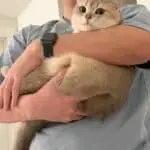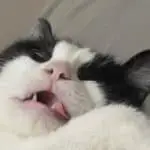Have you ever brought home a fancy new cat toy, only to find your feline friend more interested in the cardboard box it came in? This common scenario leaves many cat owners puzzled. Why are cats so drawn to simple cardboard boxes? The answer lies in a blend of instinct, behavior, and sensory attraction.
From providing a sense of security and comfort to appealing to their natural hunting instincts, these ordinary boxes are extraordinary in the eyes of our cats.
Let’s unpack the reasons behind this cardboard fascination and explore what makes boxes so irresistible to our feline companions.
Safety and Security

Cats are mysterious creatures, often surprising us with their behaviors. One such quirk is their love for paper boxes. Have you noticed how they’re drawn to these simple cardboard creations? This fascination is deeply rooted in their need for safety and security.
Consider the wild ancestors of our domestic cats. In the wild, survival depends on avoiding danger. Cats are both predators and prey, which means they need safe hiding spots to observe their surroundings and escape threats. This instinct is still strong in our house cats. When they crawl into a paper box, they’re tapping into this deep-seated need for a secure hideaway.
The confined space of a box provides a sense of enclosure and protection. It’s like a mini-fortress that shields them from the outside world. In a box, cats feel they have a vantage point to watch for danger without being seen. It’s a strategic spot for them to monitor their environment while remaining hidden.
Curiosity and Play
Cats, with their enigmatic personalities and playful antics, often find joy in the simplest of things. Among their favorite objects? Paper boxes. This peculiar attraction is not just about comfort; it’s a playground for their curiosity and a stage for their playful nature.
Why do cats love boxes so much for play? It starts with their insatiable curiosity. Cats are natural explorers, drawn to new and uncharted territories within their environment. When a new box enters the home, it presents an unknown space to be investigated and conquered. It’s a mystery waiting to be solved, and for a curious cat, that’s an irresistible call to adventure.
Then there’s the element of play. Boxes are like multi-functional play stations for cats. They jump in and out, ambush unsuspecting toys (or sometimes humans), and engage in pretend battles. The walls of a box provide cover, allowing them to hone their hunting skills in a safe, controlled environment. This play is not just for fun; it’s a critical part of their development, keeping their hunting instincts sharp.
Insulation and Comfort

Have you ever found your cat snugly curled up in a cardboard box and wondered what makes this simple item so appealing? Beyond the fun and games, boxes offer cats a unique sense of insulation and comfort that caters to their need for warmth and security.
Cats are drawn to warmth. Their ideal temperature range is higher than that of humans, so they seek out cozy spots to maintain their comfort. Cardboard boxes, with their enclosed structure, are perfect for this. The material acts as an excellent insulator, trapping the cat’s body heat and creating a warm, snug environment. This is especially appealing in cooler months or in homes with lower temperatures.
The size of the box also plays a role. Cats often prefer boxes that are just the right size for them to fit snugly. This not only helps in retaining heat but also provides a sense of security, like a warm embrace. It’s a throwback to their kitten days when they huddled with their littermates for warmth and comfort.
Stress Relief
In the life of a cat, stress can come from various sources: a busy household, new people, or even other pets. Amidst these stressors, one of their most surprising sources of relief is something you might not expect: a simple cardboard box. Here’s why these humble boxes are more than just playthings – they’re a sanctuary for stress relief.
Cats, by nature, crave a sense of control over their environment. A cardboard box provides a confined space that they can claim as their own. This defined territory offers predictability and familiarity, essential for a cat’s sense of security. When they retreat into a box, they’re in a world they can control, away from the unpredictability of their larger surroundings.
Moreover, boxes offer a sensory break. The enclosed space filters out external noise and reduces sensory input, creating a calming bubble. For cats that are easily overwhelmed by sensory overload, this can be incredibly soothing. It’s like having a personal retreat spot where they can relax, away from the chaos of daily life.
Territorial Instinct

Cats are renowned for their strong territorial instincts, and their affinity for cardboard boxes is closely linked to this trait. When a cat claims a box, it’s not just finding a cozy spot to lounge in; it’s establishing its own mini territory within your home.
In the wild, cats mark their territory to communicate with other cats. This behavior extends to our domestic felines as well. When a cat rubs against a box or sits in it, they’re leaving their scent, claiming it as their own. This scent marking is a clear signal to other pets in the household: “This is my space.”
The box serves as a physical boundary, a defined area that the cat can control. This sense of ownership is crucial for a cat’s psychological well-being. In a multi-pet household, having a space that’s exclusively theirs can reduce conflicts and stress.
Predatory Instinct
At first glance, a cat playing in a cardboard box may seem like simple amusement. However, this behavior is deeply rooted in their predatory instincts. For our feline friends, a cardboard box is more than just a toy; it’s an integral part of their natural hunting behavior.
In the wild, cats rely on stealth and surprise to catch their prey. A box offers the perfect opportunity for a domestic cat to practice these skills. The confined space allows them to hide and observe their surroundings without being seen, mimicking the way they would lie in wait for prey in nature.
Peering out from the safety of a box, they can watch for ‘prey’ – be it a toy, a human foot, or another pet – and pounce at the opportune moment.
This box play also satisfies their need for mental and physical stimulation. The act of stalking and pouncing on imaginary prey helps keep their hunting skills sharp. It’s an important exercise, particularly for indoor cats, whose natural predatory activities are limited.
Texture and Sound
Cats’ fascination with cardboard boxes isn’t just about hiding or playing; it’s also about the sensory experience they offer. The texture and sound of cardboard are particularly appealing to cats, playing a significant role in their box obsession.
The rough, corrugated texture of cardboard provides an ideal surface for cats to scratch. Scratching is a natural behavior for cats, serving multiple purposes: it helps them keep their claws sharp, allows them to stretch their bodies, and also lets them mark their territory with scent glands in their paws. The sensation of scratching cardboard is satisfying for cats, providing just the right resistance.
Then there’s the sound aspect. Cats have highly sensitive hearing, and the subtle noises that a cardboard box makes can be intriguing to them. The slight rustling sound when they move around inside the box can stimulate their auditory senses. This can be especially captivating for indoor cats, who often have a more limited soundscape to explore.








